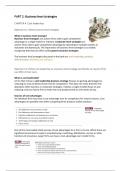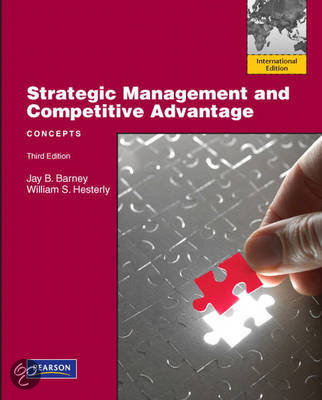PART 2: Business-level strategies
CHAPTER 4: Cost leadership
Objective 4.1: Define business level strategies
What is business-level strategy?
Business-level strategies are actions firms take to gain competitive
advantage in a single market or industry. Corporate-level strategies are
actions firms take to gain competitive advantage by operating in multiple markets or
industries simultaneously. The importance of business-level strategies is so widely
recognized that they are often called generic business strategies.
The business-level strategies discussed in the book are cost leadership, product
differentiation, flexibility and collusion.
Objective 4.2: Define cost leadership as a business level strategy and identify six reasons firms
can differ in their costs
What is cost leadership?
A firm that choose a cost leadership business strategy focuses on gaining advantages by
reducing its costs to below those of all its competitors. This does not mean that this firm
abandons other business or corporate strategies. Indeed, a single-minded focus on just
reducing costs can lead a firm to make low-cost products that no one wants to buy.
Sources of cost advantages
An individual firm may have a cost advantage over its competitors for several reasons. Cost
advantages are possible even when competing firms produce similar products.
One of the most widely cited sources of cost advantages for a firm is its size. When there are
significant economies of scale in manufacturing, marketing, distribution, service or other
functions of a business, larger firms can have a cost advantage over smaller firms.
,Just as (1) economies of scale can generate cost advantages for larger firms, important (2)
diseconomies of scale can actually increase costs if firms grow too large. As figure below
shows, if the volume of production rises beyond some optimal point, this can actually lead to
an increase in per-unit costs.
A third possible source of cost advantages for firms in a particular business depends on their
different cumulative levels of production. In some circumstances, firms with the greatest
experience in manufacturing a product or service will have the lowest costs in an industry
and thus will have a cost-based advantage. The link between cumulative volumes of
production and cost has been formalized in the concept of the (3) learning curve.
As depicted in the picture, the learning curve is very similar to the concept of economies of
scale. However, there are two important differences. First, whereas economies of scale
focus on the relationship between the volume of production at a given point in time and
average unit costs, the learning curve focuses on the relationship between the cumulative
volume of production. Second, where diseconomies of scale are presumed to exist if a firm
gets too large, there is no corresponding increase in costs in the learning-curve model as the
cumulative volume of production grows. Rather, costs continue to fall until they approach
the lowest technologically possible cost.
Besides economies of scale, diseconomies of scale, and learning-curve cost advantages,
differential low-cost access to productive inputs may create cost differences among firms
producing similar products in an industry. (4) Productive inputs are any supplies used by a
firm in conducting its business activities; they include, among other things, labor, capital,
land, and raw materials. A firm that has differential low-cost access to one or more of these
factors is likely to have lower economic costs compared to rivals.
Another possible source of cost advantage in an industry may be the different technologies
that firms employ to manage their business. It has already been suggested that larger firms
may have (5) technology-based cost advantages that reflect their ability to exploit
economies of scale (e.g., the two-thirds rule). The concept of firm technology includes not
only the technological hardware, but also the technological software.
, Thus far, this discussion has focused on reasons why a firm can gain a cost advantage despite
producing products that are similar to competing firm’s products. When firms produce
essentially the same outputs, differences in economies of scale, learning curve advantages,
differential access to productive inputs, and differences in technology can all create cost
advantages (and disadvantages) for them. However, firms can also make choices about the
kinds of products and services they will sell. Choices that have an impact on their relative
cost position. These choices are called (6) policy choices.
Objective 4.3: Describe how cost leadership can create economic value for a firm
Cost leadership and environmental threats
A cost leadership competitive strategy helps reduce the threat of new entrants by creating
cost-based barriers to entry.
Objective 4.4: Identify the bases of cost leadership that are more likely to be rare and costly
to imitate and those that are less likely to be rare and costly to imitate
Cost leadership and sustained competitive advantage
Given that cost leadership can be valuable, an important question becomes: “Under what
conditions will firms implementing this business strategy be able to maintain that leadership
to obtain a sustained competitive advantage?” If cost leadership strategies can be
implemented by numerous firms in an industry or if no firms face a cost disadvantage in
imitating a cost
leadership strategy,
then being a cost
leader will not
generate a sustained
competitive advantage
for a firm.





